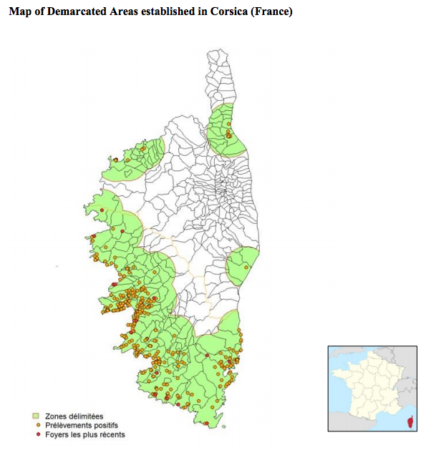I just can’t resist following up yesterday’s Nibble on the history of citrus fruits in the Mediterranean with a couple of recent news stories about unconventional uses for orange peels. To wit, making clothes and environmental restoration. What would those Romans who first introduced the citron and lemon have thought? Let’s just hope we’re able to enjoy this multi-use genus a little while longer.
Nibbles: Jumping genes, Lebanese winemaking, Ag data, Ag & soil C, Citrus routes, Breeding peas, Heritage cattle
- Pinning down transposable elements across the whole maize genome.
- Wine and weed in Lebanon. Not as mellow as it sounds.
- Yields and Land Use in Agriculture: The Website.
- The effect of all those yields times 12,000 years on C sequestration is about as much as that of deforestation.
- Ancient Roman 1% responsible for introducing the citron and lemon to the Mediterranean.
- Flowering duration and pod numbers are they keys to heat tolerance in peas.
- 94% of US dairy cows are Holsteins. How boring is that?
Nibbles: Weird genebank, Wheat history, NJ blueberries, Xoloitzcuintle, Cemetery prairie, Tenure, Sunflower at USDA, Potato breeding book, Cullinary diversity, Genomics & breeding, Migration report
- There’s a genebank for algae and protozoans.
- How Turkey Red Wheat from Ukraine built Kansas.
- Taming the wild blueberry.
- History of the ugliest dog breed in the world.
- The prairie lives on among the dead.
- Speaking of which: land tenure and conservation.
- Conserving and breeding sunflowers in the US.
- Making potato breeding great again.
- M.S. Swaminathan recommends millets.
- Computing our way to food security.
- Food insecurity and migration.
Brainfood: Mycorrhizal diversity, Olive diversity, Teak diversity, Core software diversity, Cost-benefit, Frosty rye, CGIAR future, Portuguese beans, Improvement networks, Food sovereignty
- Historical biome distribution and recent human disturbance shape the diversity of arbuscular mycorrhizal fungi. Proximity to tropical grasslands during the last glacial maximum makes for a large potential species pool, remoteness from human disturbance for the presence of a high percentage of that pool.
- The First Molecular Identification of an Olive Collection Applying Standard Simple Sequence Repeats and Novel Expressed Sequence Tag Markers. 59 genotypes among 370 trees.
- Worldwide translocation of teak—origin of landraces and present genetic base. The dryer part of the natural range has not really been used in plantations.
- GenoCore: A simple and fast algorithm for core subset selection from large genotype datasets. Better than MSTRAT, Core Hunter, and random sampling.
- Global economic trade-offs between wild nature and tropical agriculture. We can go ahead and cut down the Atlantic Forest. Wait, what?
- Exploring new alleles for frost tolerance in winter rye. Basically one allele, actually.
- Reforming the research policy and impact culture in the CGIAR: Integrating science and systemic capacity development. Let CGIAR be CGIAR.
- Improving global integration of crop research. Taking this to the next level. Which sounded a lot like the International Treaty’s Global Information System on PGRFA. Also, see above.
- Establishing the Bases for Introducing the Unexplored Portuguese Common Bean Germplasm into the Breeding World. 37 accessions had 100% of the diversity of 175 accessions, which were mainly hybrids between the two main genepools. I don’t think I’ve ever seen that before.
- Plant diversity increases with the strength of negative density dependence at the global scale. Janzen-Connell were right, it’s natural enemies that explain the tropical-temperate diversity pattern. With video goodness.
- Local food sovereignty for global food security? Highlighting interplay challenges. “…scaling up of food sovereignty will not necessarily lead to wider sustainability and food security outcomes.”
Xylella spreads shock
A few days ago the European Commission published its “List of demarcated areas established in the Union territory for the presence of Xylella fastidiosa as referred to in Article 4(1) of Decision (EU) 2015/789” and the news is not good for Corsica, the Balearics and assorted other areas.

A good summary of the story 1 so far, and what’s in store for us, can be found on Small Things Considered in the form of a translation from the Catalan of a blog post by Mercè Piqueras.
A conference on European research into Xylella fastidiosa is to be held in Palma de Mallorca, in the Balearic Islands, in 13-15 November 2017. Experts on Xylella from Europe and other parts of the world will participate in the meeting. These include Alexander Purcell, Rodrigo Almeida and Mathieu Vanhove, from the University of California-Berkeley, Carlos Chacón, from the University of Costa Rica, and Helvecio De La Coletta-Filho, from the Instituto Agranomico-Centro de Citricultura, Brazil.
Meanwhile, nurseries are mounting their own private Brexit.